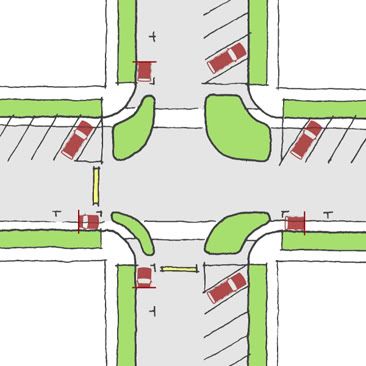A few months ago I wrote about the benefits of curb extensions. Soon thereafter, some Alamitos Beach residents asked me how curb extensions might used on their neighborhood’s streets. Also called “sidewalk bulb-outs,” curb extensions are sections of sidewalk that project into the street, thereby reducing the distance pedestrians must traverse when crossing the street in question. On top of calming automobile traffic and increasing pedestrian safety, curb extensions provide for additional on-street parking. As is the case in many of the neighborhoods that surround the downtown area, parking is scarce in Alamitos Beach. Since many streets in these neighborhoods are quite wide, they could benefit greatly from curb extensions.
Where curb extensions are not in place, curbside parking ends twenty to thirty feet before an intersection (marked with a red curb), to ensure a safe level of visibility for pedestrians and oncoming vehicular traffic. Stop signs are normally placed ten to fifteen feet from the intersection so that automobiles remain behind the line of pedestrian traffic crossing the intersection. Curb extensions, however, stick out into the parking lane. As a result, pedestrians can move out as far as a parked car without actually being in the street. This provides much greater visibility for both drivers and pedestrians, which eliminates the need for red curbs except for a small area at the intersection itself. The additional ten to twenty feet of available curbside at each intersection can create enough room for an additional parallel parking stall. In many neighborhoods surrounding the downtown area (for instance, Willmore City, Drake Park, East Village, and Alamitos Beach) the relatively wide streets have been provided with diagonal parking on one side and parallel parking on the other. In such cases, the additional ten to twenty feet of available curbside that curb extensions make available is enough for an additional diagonal stall. Where two such wide streets intersect, curb extensions could yield as much as six additional parking stalls. In the Alamitos Beach neighborhood alone, this translates to over 150 new parking stalls near those residents who need them the most—parking stalls that would require no administration of public lots or negotiations with private property owners to share their lots.
When I discussed the idea of curb extensions with Long Beach’s Traffic Engineer, he expressed a concern that curb extensions could interfere with storm water drainage. Re-grading streets to divert drainage around curb extensions could significantly raise the cost of installing such curb extensions. In addition, the city must consider whether or not the existing disabled-accessible curb ramps at intersections would need to be reconfigured were curb extensions to be installed. Both of these potential costs could, in theory, make curb extensions infeasible during this period of fiscal conservancy.
However, recent advances in stormwater management provide a potential sustainable solution. In 2003, Portland developed the NE Siskiyou Green Street which captures, slows, and cleanses stormwater in two 50-foot-long curb extensions along an existing residential street. Stormwater enters the curb extensions via breaks along its edge. The stormwater is then naturally filtered through layers of sand, gravel, and soil planted with native plants. It then soaks into the ground, recharging local aquifers rather than entering the existing stormwater sewer system.
Such a concept could be adopted in Long Beach’s most parking-impacted neighborhoods, and they could be installed far enough from intersections to avoid interfering with the existing curb ramps. Limiting the impact of such curb extensions in this manner would greatly reduce construction costs. Installation costs for stormwater management curb extensions of this type range from ten and fifteen thousand dollars; extended over twenty-five intersections in Alamitos Beach, this would total around 1.5 million dollars. To put it in perspective, that is about as much as it would cost to purchase the least expensive full-size lot in Alamitos Beach, remove the existing structure and pave it for twenty parking stalls. While not an insignificant expense, the benefits to pedestrian safety, stormwater management, neighborhood beautification, and quality of life—not to mention a net gain in on-street parking—certainly justify the expense.

Net gain of six parking stalls per typical intersection


